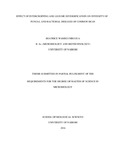| dc.description.abstract | Common bean (Phaseolus vulgaris L.) is an important grain legume cultivated in Kenya.
Bacterial and fungal diseases are a major constrain in production of common bean in
Western Kenya. This study assessed the effect of intercropping and legume
diversification on the intensity of bacterial and fungal diseases of common bean in three
cluster sites in lower midland one (LM1) in Butula and Teso South Divisions, Busia
County, Western Kenya. The study was carried out during the long rains season of 2015
(April - July) where ten farms in each cluster were selected based on similarities in
characteristics such as soil types, altitude, rainfall, temperature, land use, head of
household, and farm typology. Planting was done at the start of long rains in April 2015
in which each farm per cluster was a replicate. Rose coco bean seeds from previous
seasons, certified KK8 and KATX56 seeds from the market were planted. Each farm in
the three clusters accommodated six experimental units, three measuring 10 x 10 m and
the other three measuring 5 x 5m. In the 10 x 10 m plots, three treatments were included
while the small plots (5 x 5 m) accommodated sole crops of each variety of common
bean. Treatment one accommodated an intercrop of Rose coco and maize. Treatment two
involved intercropping of three common bean varieties - Rose coco, KAT56 and KK8 -
with maize, while treatment three involved intercropping Rose coco, KAT56 and KK8
bean varieties with groundnuts (Red Valencia), cow pea (K80) and maize. The other
three sole treatments, on the small 5 x 5 m plots, accommodated pure bean stands of Rose
coco, KATX56 and KK8. In each of the intercropped treatments, the legumes were
planted in double rows between two maize rows. The spacing of maize was 75 × 30 cm
while that of bean was 30 ×15 cm. Soil samples were collected for nutrient status analysis
and for determination of the population and diversity of soil borne pathogens. Samples of
common bean roots and above ground plant parts were collected for evaluation of root rot
and foliar diseases, respectively. Seed samples were also collected before planting and
after harvesting and were analyzed for purity, germination and bacterial contamination as
outlined in International Seed Testing Association (ISTA). The soil samples had low
nutrient levels and were highly acidic (pH range: 5.1-5.8). Major soil borne fungal
pathogens isolated from the soil were Fusarium solani, Fusarium oxysporum,
Rhizoctonia solani, Macrophomina phaseolina and Pythium spp. Other fungal genera
isolated in low frequency from the soil were Aspergillus spp., Penicillium spp.,
Trichoderma spp. and Curvularia spp. Root rot causing pathogens that were isola | en_US |



